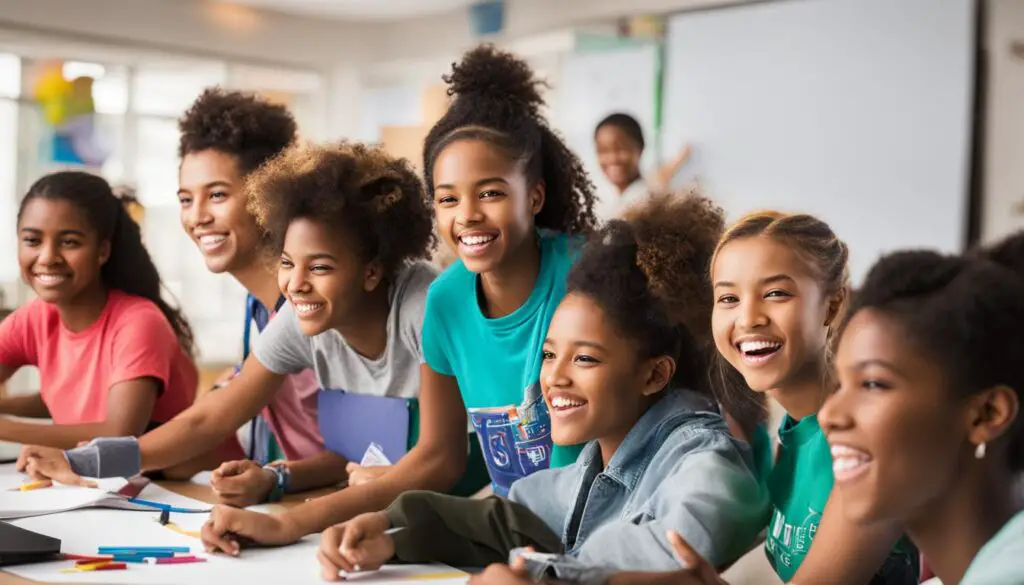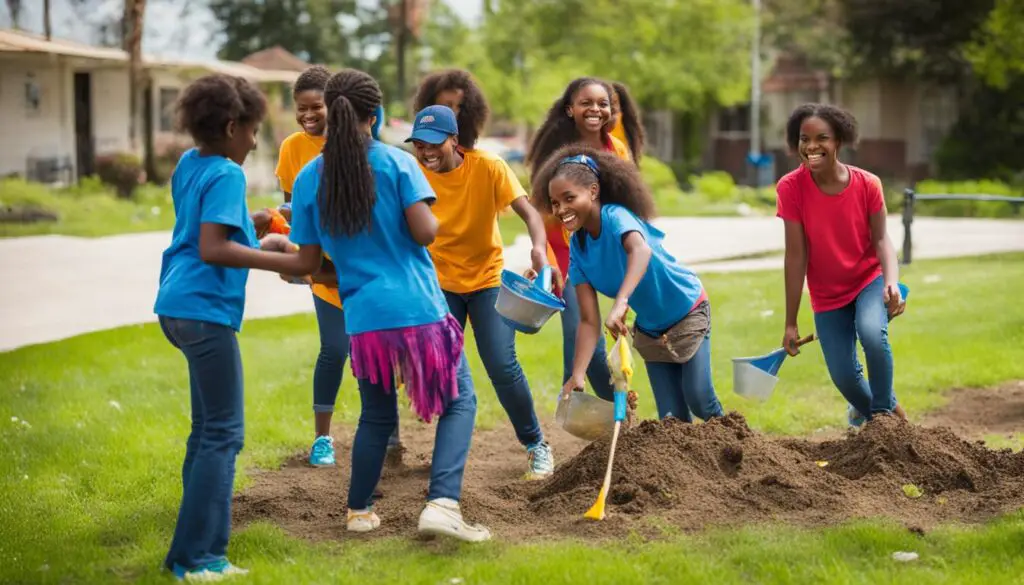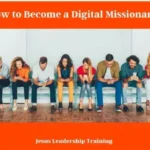Youth group activities have the power to engage and inspire young members of the congregation. By incorporating meaningful and impactful activities, youth leaders can educate and empower the youth, while also creating a sense of fun and excitement. These activities provide an opportunity for the youth to learn important lessons and values that can have a lasting impact on their lives.
Key Takeaways
- Meaningful and impactful youth group activities can educate and empower young members of the congregation.
- Engaging youth activities foster a sense of fun and excitement while teaching important lessons and values.
- Interactive activities allow for active participation and promote teamwork.
- Empowering activities help the youth develop important life skills and make a positive impact on their communities.
- Inspiring activities create a sense of purpose and encourage the youth to live out their faith.
5 Great Activities that Teach a Clear Message
When it comes to youth group activities with a message, incorporating biblical principles is essential. These activities provide an engaging and impactful way to teach young individuals about important topics such as temptation, Jesus, rewards, and decision-making. By weaving these messages into fun and interactive experiences, we can inspire the youth to live according to biblical values and principles. Here are five great activities that deliver a clear message:
“Mystery Prize” – Dealing with Temptation
The “Mystery Prize” activity presents the concept of temptation through a lively debate among students. They are given the choice to open different prizes, each representing a decision with consequences. This activity teaches the importance of making choices and the potential rewards or consequences that follow.
“The Good Life” – Following God’s Instructions
Inspired by biblical teachings, “The Good Life” activity focuses on the importance of following God’s instructions rather than chasing after worldly desires. Students explore magazines to analyze the messages society promotes and reflect upon their own values and priorities.
“Trail of Doom” – The Cost of Discipleship
In “Trail of Doom,” students embark on a simulated hiking journey that represents the challenges and sacrifices faced by followers of Christ. This activity requires teamwork and problem-solving skills as students navigate through various obstacles, emphasizing the cost and rewards of discipleship.
“The Bigger Picture” – Eternal Perspective
With “The Bigger Picture” activity, students are encouraged to have an eternal perspective and shift their priorities. By creating yarn-wrapped cardboard letters that display a message of God’s love, they engage in a creative and reflective exercise that reminds them of the greater purpose and meaning of life.
Serving Others Through Youth Activities
Lastly, an activity that promotes service and selflessness is organizing community service games and acts of kindness. By engaging in these activities, students learn the value of serving others, develop empathy, and cultivate a heart for making a positive impact in their communities.

These five activities are just a glimpse of the wide range of youth group activities that can teach biblical principles and deliver a clear message. By incorporating these activities into your youth group program, you can inspire and educate the youth, fostering their spiritual growth and guiding them towards a deeper understanding of their faith.
Teaching youth through games is a brilliant way to facilitate learning. Games are engaging, interactive, and can make complex concepts more accessible. Here are ten reasons why it’s an effective method:
- Engagement: Games capture young people’s attention and keep them engaged in the learning process.
- Motivation: The fun nature of games motivates students more than conventional teaching methods. Winning a game or achieving a goal can boost their willingness to participate.
- Interactive Learning: Games encourage active participation, which can promote better comprehension and retention of information.
- Teamwork: Many games necessitate cooperation and collaboration, teaching young people to work effectively as a team.
- Problem-Solving Skills: Games often involve puzzles or situations that must be solved, which can improve critical thinking and problem-solving skills.
- Enhances Memory: The repetitive nature of games improves memory recall, making it easier for young people to remember facts or concepts.
- Reduced Stress: Games can make the learning environment less stressful and intimidating, promoting better learning outcomes.
- Instant Feedback: Games often provide immediate feedback, allowing youth to understand their mistakes and learn from them quickly.
- Real-World Application: Games can simulate real-world scenarios, teaching youth how the knowledge they’re gaining applies outside the classroom.
- Encourages Creativity: Games often require creativity and innovation, encouraging young people to think outside the box.
It’s important to remember that while games are an effective teaching tool, they should be a part of a diverse range of teaching methods to cater to different learning styles.
Engaging Youth Group Activities
Engaging youth group activities come in various forms and serve different purposes. These activities are designed to create a dynamic and impactful experience for the students, fostering their personal and spiritual growth. By incorporating a variety of interactive games, team building exercises, serving others, get-to-know-you activities, and spiritual practices, youth leaders can effectively engage and inspire their young members.
Interactive Games for Participation and Teamwork
Interactive games are an excellent way to promote participation and encourage teamwork among the youth. These games create a fun and engaging environment that allows students to actively participate and learn from one another. Whether it’s a collaborative puzzle-solving activity or a competitive team challenge, interactive games provide opportunities for students to develop crucial skills such as communication, problem-solving, and cooperation.
Team Building Activities for Unity and Communication
Team building activities bring the youth together in a structured environment that promotes unity and teamwork. These activities focus on developing trust, effective communication, and understanding among the group members. Through team-building exercises, students learn to work together, rely on each other’s strengths, and overcome challenges as a cohesive unit, fostering a sense of camaraderie and belonging.
Serving Others for Compassion and Selflessness
Engaging in activities that involve serving others teaches the value of compassion and selflessness to the youth. Whether it’s organizing community service projects, participating in acts of kindness, or engaging in volunteer work, these activities provide a tangible way for students to make a positive impact on the lives of others. By serving others, youth learn the importance of empathy, kindness, and the joy that comes from helping those in need.
Get-to-Know-You Activities for Building Relationships
Get-to-know-you activities provide opportunities for students to build relationships and feel a sense of belonging within the youth group. These activities break the ice, create a relaxed atmosphere, and encourage students to open up and share about themselves. Whether it’s playing icebreaker games, engaging in group discussions, or participating in team-building exercises, get-to-know-you activities foster a sense of community and connection among the youth.
Spiritual Activities for Deepening Faith and Growth
Spiritual activities focus on deepening the students’ faith and facilitating their spiritual growth. These activities may include one-verse Bible studies, quick prayer meetings, or discussions based on the previous week’s sermon. By engaging in these practices, youth develop a deeper understanding of their faith, explore their beliefs, and strengthen their relationship with God and each other.

Physical Activities
Incorporating physical youth group activities is an excellent way to harness the energy of students and promote active participation. These activities not only promote physical health but also offer opportunities for students to bond, build camaraderie, and learn important life skills. Here are a few exciting physical activities that are sure to engage and excite the youth:
Life-Size Tic Tac Toe
Life-size tic tac toe is a thrilling twist on the classic game that encourages teamwork and strategic thinking. By transforming a traditional grid into a large-scale playing field, students can immerse themselves in a dynamic and interactive experience. This activity promotes problem-solving skills, decision-making, and collaboration. It’s a perfect way to get the youth moving and thinking strategically while having loads of fun.
Simulated Bank Robbery Challenge
Organizing a simulated bank robbery challenge is an adventurous activity that requires problem-solving skills and agility. Students will work together as a team to crack codes, decipher clues, and complete challenges to successfully solve the mystery. This activity not only stimulates critical thinking but also encourages effective communication and teamwork. It’s an exhilarating experience that will leave a lasting impact on the participants.
Worm Olympics
The Worm Olympics is a light-hearted and entertaining competition that allows students to showcase their physical abilities through fun challenges. From silly races to imaginative obstacle courses, this activity will have the youth laughing and cheering each other on. The Worm Olympics promote healthy competition, encourage self-expression, and create a sense of unity among participants. It’s a unique and engaging way to celebrate the physical talents within the youth group.
By incorporating these physical youth group activities, leaders can provide an outlet for students to engage in physical exercise, develop essential skills, and build strong relationships with their peers. These activities not only promote physical well-being but also create memorable and impactful experiences for the youth.

Incorporating physical activities into the youth group program is an excellent way to promote active participation and create meaningful connections.
Creative Activities
Engaging in creative activities allows youth group members to express themselves and explore their artistic abilities. By participating in hands-on crafting projects, such as yarn-wrapped cardboard letters and woolen hearts, students can create meaningful and visually appealing artwork while also conveying messages of faith and love.
The process of creating these artistic representations provides an opportunity for reflection on individual beliefs and personal expressions of faith. It encourages students to explore their understanding of God’s love and share that love with others through tangible creations.
This type of creative activity not only fosters artistic skills but also deepens the connection between faith and personal expression. Through these projects, youth group members can explore the beauty of self-expression and find new ways to incorporate their faith into their daily lives.

Yarn-Wrapped Cardboard Letters
Yarn-wrapped cardboard letters are a popular creative activity in youth groups. This project involves covering cardboard letters with colorful yarn to create visually appealing decorations that can be displayed in various settings.
The process of wrapping the yarn around the letters allows students to engage in a meditative and therapeutic activity while also expressing their faith. They can select yarn colors that represent different aspects of their spiritual journey and incorporate meaningful designs or patterns. The end result is a beautiful, personalized piece of art that serves as a reminder of God’s presence and love.
Woolen Hearts
Another creative activity that youth groups can engage in is making woolen hearts. This project involves shaping and wrapping colorful wool or yarn into heart-shaped ornaments. The woolen hearts can be used as decorations, given as gifts, or used in group prayer or reflection sessions.
The process of creating these woolen hearts provides a tangible way for youth to reflect on their own belief in God’s love. As they shape and mold the wool, youth group members can contemplate their personal experiences of love and gratitude towards God. The hearts serve as a physical representation of their connection to their faith and a reminder of the love that surrounds them.
Incorporating these creative activities in youth group sessions allows for a holistic approach to spiritual growth and self-expression. By engaging in hands-on crafting projects like yarn-wrapped cardboard letters and woolen hearts, youth can deepen their understanding of faith while exploring their artistic abilities. These activities foster creativity, self-reflection, and a deeper connection to God’s love.
Serving Others Through Youth Activities
Serving others through youth activities is a powerful way to instill compassion and empathy in young individuals. By engaging in community service games and acts of kindness, youth groups can make a positive impact and spread a message of love and selflessness.
One popular activity is the “Random Acts of Kindness Challenge,” where students are encouraged to perform small acts of kindness for others throughout the day. This could include writing uplifting notes, helping someone with their groceries, or simply offering a listening ear.
Another impactful activity is organizing a volunteer day at a local shelter or food bank. This gives youth the opportunity to directly contribute to the well-being of their community and learn the importance of giving back.
Senior citizen outreach programs are also a meaningful way to serve others and foster intergenerational connections. Whether it’s hosting a game night at a senior center or organizing a craft session, these activities not only bring joy to the elderly but also teach the youth the value of respecting and caring for older generations.
Remember, serving others is not just about the physical acts of kindness; it’s also about the message behind those acts. By engaging in community service games, acts of kindness, and senior citizen outreach, youth groups can convey a powerful message of love, compassion, and unity.

The Impact of Serving Others
“Service to others is the rent you pay for your room here on earth.” – Muhammad Ali
Serving others through youth activities has a profound impact on both the individuals being served and the young volunteers themselves. When youth engage in acts of kindness and community service, they develop a greater sense of empathy, compassion, and gratitude. They learn that even small actions can make a big difference in someone’s life and that they have the power to positively impact the world around them.
Serving others also teaches youth important life skills such as teamwork, leadership, and problem-solving. When working together to organize community service games or plan volunteer days, youth learn how to collaborate, communicate effectively, and overcome challenges.
The Benefits of Serving Others
| Benefits for Youth | Benefits for the Community |
|---|---|
| Develops empathy and compassion | Creates a sense of unity and connection |
| Builds leadership and teamwork skills | Addresses community needs |
| Fosters personal growth and self-esteem | Improves the well-being of individuals |
| Promotes a sense of social responsibility | Strengthens community bonds |
| Provides an opportunity for self-reflection and personal values | Inspires others to pay it forward |
By engaging in youth group activities with a message of serving others, we can empower the next generation to be compassionate, selfless, and actively involved in making the world a better place. Together, we can create a ripple effect of kindness and inspire others to join in the movement of service.
Get-to-know-you Activities
Building relationships within the youth group is essential for creating a sense of community and belonging. Get-to-know-you activities provide an opportunity for students to connect with one another on a deeper level and break down barriers. By incorporating fun and interactive icebreaker games and youth group games, youth leaders can foster a relaxed and inviting atmosphere that encourages students to open up and share about themselves. These activities pave the way for meaningful connections and lay the foundation for lasting friendships.
Icebreaker Games
Icebreaker games are a fantastic way to initiate conversations and create a positive atmosphere for the youth group. One popular icebreaker game is “M&M Roulette,” where participants take turns picking M&M candies with each color representing a different question or prompt. Another exciting game is “Dice and Dare,” where players roll dice and perform a challenge based on the number they land on. “This or That,” a classic game that presents two options, encourages students to share their preferences and spark interesting discussions. These icebreaker games bring laughter, excitement, and engagement, allowing students to learn more about each other while having a great time.
Sample Icebreaker Game: M&M Roulette
| Color | Prompt |
|---|---|
| Red | Share your favorite movie and why it resonates with you. |
| Blue | Tell a funny childhood memory that still makes you laugh. |
| Green | Discuss a dream or goal you have for the future. |
| Yellow | Share a talent or skill you possess. |
| Brown | Talk about a place you would love to travel to and why. |
| Orange | Share a challenging situation you overcame and the lessons you learned. |
Youth Group Games
Aside from icebreaker games, there are various youth group games specifically designed to help students get to know each other better. These games promote interaction and teamwork while providing opportunities for students to reveal their personalities, interests, and experiences. Whether it’s a group scavenger hunt, a friendly competition, or a themed game night, youth group games encourage collaboration and bonding while creating lasting memories.
Sample Youth Group Game: Dice and Dare
“Dice and Dare” is an exciting game where players take turns rolling a dice and performing a corresponding challenge. Each number on the dice represents a different dare or task. For example:
- Roll a 1: Sing a verse from your favorite song in front of the group.
- Roll a 2: Do an impromptu dance routine.
- Roll a 3: Share your most embarrassing moment.
- Roll a 4: Act out a scene from your favorite movie.
- Roll a 5: Recite a poem or a favorite quote.
- Roll a 6: Perform a random act of kindness for someone in the room.
This game encourages students to step out of their comfort zones, showcase their unique talents, and learn more about each other through lighthearted challenges.
Spiritual Activities
Engaging in spiritual activities is an essential part of the youth group experience. These activities provide opportunities for students to deepen their faith, connect with biblical teachings, and grow spiritually. Whether through focused Bible study, heartfelt prayer meetings, or meaningful discussions about last week’s sermon, these activities foster a sense of connection to God and real-life application of faith.
One-Verse Bible Study
An impactful way to engage students in the study of God’s Word is through one-verse Bible studies. By diving deep into a specific scripture, students can explore its meaning, context, and practical application. This focused approach allows for a thorough understanding of a single verse and empowers students to draw personal insights and connections to their own lives.
Quick Prayer Meeting
In youth group, prayer becomes a powerful tool for support and connection. Quick prayer meetings create a safe space for students to share their prayer requests, seek guidance, and intercede for one another. These short but meaningful gatherings foster a sense of community and reinforce the importance of prayer in their spiritual journey.
“Last Week’s Sermon” Discussion
Reflecting on and discussing the key messages from the previous week’s sermon is a valuable activity for youth group members. These discussions allow students to deepen their understanding of the sermon’s teachings, ask questions, and share personal insights and experiences. It nurtures a sense of active engagement with God’s Word and provides an avenue for applying the sermon’s lessons to real-life situations.
“God’s Word is living and active, and through these spiritual activities, our youth group members can experience its transformative power in their lives.”
By incorporating these spiritual activities into youth group sessions, leaders can nurture the spiritual growth of their students, encourage meaningful connections to God’s Word, and inspire a vibrant and life-giving faith.
Passive Activities
Passive activities in youth group provide a platform for discussing relevant topics and messages encountered in popular culture. These activities allow students to engage with media, explore themes, and reflect on the messages portrayed.
Movie nights create an opportunity for students to immerse themselves in films while also examining the underlying themes and messages. By watching movies together, youth group members can engage in meaningful discussions about the characters, plot, and moral lessons presented.
YouTube Clip Discussion
YouTube clip discussions provide a platform for meaningful conversations around the ideas presented in videos from influential speakers. By sharing and analyzing thought-provoking clips, students have the opportunity to explore different perspectives and deepen their understanding of various topics.
Latest News Discussion
Latest news discussions prompt students to think critically about current events and consider the role of the church in addressing relevant issues. By discussing news articles or headlines, youth group members can analyze and reflect upon the messages they encounter in their daily lives and explore how their faith intersects with the world around them.
Conclusion
Youth group activities with a message have the power to engage and inspire young members of the congregation. By incorporating a diverse range of activities that promote spiritual growth, teamwork, creativity, and service, youth leaders can facilitate the holistic development of the youth. These engaging activities not only have a meaningful impact but also foster a sense of community and belonging among the youth.
By prioritizing the message behind these activities, youth leaders can empower and inspire the next generation of believers. The integration of meaningful messages in youth group activities allows young individuals to learn important lessons and values that can shape their character and guide their decisions. Through these activities, they can develop a deeper understanding of their faith and cultivate a strong sense of purpose.
Furthermore, the holistic development fostered by these activities encompasses various aspects of the youth’s lives. They not only promote spiritual growth but also develop essential life skills such as teamwork, problem-solving, and empathy. The hands-on and interactive nature of these activities make learning enjoyable and instill a passion for lifelong learning and personal growth in the youth.
In conclusion, youth group activities with a message are a powerful means of engaging, inspiring, and empowering young individuals within the congregation. Through these activities, youth leaders can make a meaningful impact on the lives of the youth, fostering their holistic development and paving the way for them to become active and purpose-driven believers in the future.
FAQ
What is the purpose of youth group activities with a message?
The purpose of youth group activities with a message is to engage and inspire young members of the congregation, while also teaching them important lessons and values that can have a lasting impact on their lives.
Can you provide examples of youth group activities that teach a clear message?
Yes, here are five examples: “Mystery Prize” focuses on dealing with temptation, “The Good Life” teaches the importance of following God’s instructions rather than worldly desires, “Trail of Doom” emphasizes the cost of discipleship and challenges faced by followers of Christ, “The Bigger Picture” encourages an eternal perspective and shifting priorities, and a community service activity focuses on serving others.
What are some engaging youth group activities?
Engaging youth group activities can include interactive games, team-building exercises, serving others through community service, and get-to-know-you activities.
What physical activities can be included in youth group activities?
Physical activities in youth group can include playing life-size tic tac toe, organizing a simulated bank robbery challenge, or hosting a worm Olympics competition.
What are some creative activities that can be included in youth group activities?
Creative activities in youth group can include making yarn-wrapped cardboard letters or woolen hearts to convey meaningful messages and deepen students’ understanding of God’s love.
How can youth activities serve others?
Youth activities can serve others through community service games, random acts of kindness challenges, volunteer days at local shelters or food banks, and senior citizen outreach programs.
What are some get-to-know-you activities for youth groups?
Get-to-know-you activities can include icebreaker games like M&M roulette, dice and dare, or this or that questions to create a fun and relaxed atmosphere for students to open up and share about themselves.
What spiritual activities can be included in youth groups?
Spiritual activities in youth groups can include one-verse Bible studies, quick prayer meetings, and discussions about the previous week’s sermon to foster spiritual growth and connection to biblical teachings.
What are some passive activities that can be included in youth groups?
Passive activities can include movie nights, YouTube clip discussions, and latest news discussions to encourage students to think critically about the messages they encounter in popular culture and current events.
How do youth group activities with a message impact young members?
Youth group activities with a message have a meaningful impact by engaging and inspiring young members, fostering a sense of community and belonging, and empowering students with important life lessons and values.
















